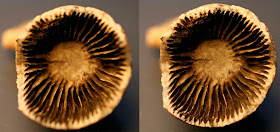Pages
▼
Wednesday, December 15, 2010
Horn Coral Image Processed with Helicon
Image of a horn coral that might be either a Hetrophrentis or Siphonophrentis of the Beechwood Member, North Vernon Limestone, Givetian Stage. The new twist on these image is that they are composites of 2-5 images created by Helicon Focus 5.1. After using the software with just the default it was very quick to start producing processed images. Right now I am using the 30 day evaluation version. This program would be really nice to process microscope images.
The image below illustrates the difference between a DSLR camera with 50 mm macro lens image and the Helicon stacked image on the right. One can see that the depth of field of the lens only lets the middle section of the horn coral to be in focus leaving the top and bottom views blurred. If a series of images are taken which gradually brings sections of the object into focus, the stacking software can combine the focused sections to create a composite image. This effect can really be seen on microscope images where the specimen has lots of depth. I do not have a fixed camera mount for the microscope so composite imaging cannot be demonstrated.
The image stacking software was produced by the Ukrainian company Helicon Soft Ltd. From what I have seen so far, a very nice piece of software. There is a stacking feature in Photoshop but I did not produce the results like those shown here. Maybe I am using it incorrectly though.
Horn coral fossil is from the Middle Devonian Period and was found in Clark County, Indiana, USA.

